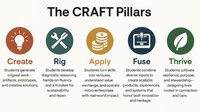Canva, the global online design platform used by more than 30 million people every month that is also the educational tool of choice for 90,000 schools and universities, announced new research findings highlighting the adverse effect this unprecedented time is having on teachers and their students across the country.
The Canva National Education Survey: Fall 2020 reveals the new school year amidst a global pandemic is already taking a toll on students. The findings illustrate 41 percent of pupils are confiding in their teachers that they are feeling overwhelmed, 39 percent have shared they are feeling disconnected from their peers and school network, 37 percent are experiencing heightened levels of anxiety, 37 percent are feeling isolated, 30 percent are worried about their friends and family, 27 percent are feeling stressed about their home environment and 26 percent are feeling depressed.
According to Dr. Vanessa Lapointe, Canva for Education ambassador and registered psychologist with a focus in working with children and families, there is no question this pandemic is having an extraordinary impact on children. “During this time, adults have experienced a high degree of stress around all of the unknowns. That kind of energy from parents, caretakers and other adults is where kids are taking their cues from,” said Dr. Lapointe.
“To help alleviate the emotional gravity surrounding the current global environment, the best way to talk to children about big life changes is to make sure you communicate on their level. Children, regardless of age, want concrete answers to questions. The more adults can be the providers of information, the more at ease and confident children tend to be in their own environment; it lessens anxiety and makes them feel more in control. If you don’t happen to have the information, then saying something along the lines of, ‘We’re not really sure, but together, we’re going to find our way through it,’ is still as important a conversation to have,” explained Dr. Lapointe.
Students are not the only ones feeling strained by the pandemic. According to the Canva National Education Survey: Fall 2020, 65 percent of educators are fearful of being personally exposed to COVID-19, with a quarter of all respondents lacking faith in their educational institutions’ ability to keep teachers and the broader school community protected against COVID-19. Furthermore, 85 percent of teachers surveyed claimed remote learning is making it difficult to maintain a connection with their students.
It’s clear building and maintaining a connection with each student is absolutely critical in this current climate. To empower teachers to build the much-needed foundational connection with students this school year, Dr. Lapointe recommends several proven strategies to help educators build relationships and maintain connections with students in this ‘new normal.’
Top Tips to Build Teacher-Student Connections during COVID:
- Make sure you understand what’s going on for your students. These are unprecedented times and you can be a source of guidance and compassion for them.
- Create an environment that feels safe. Safety will stem from routine and structure in an empowering way; get focused and set your physical or virtual classroom up so your students can lean into the comfort and stability of the environment.
- Make sure you value relationships over curriculum. Make it very clear to your students that their well-being is what’s most important to you.
As those in the education sector are forced to rethink how a curriculum is delivered, ensuring every child has the access they deserve to a quality education is of utmost importance to Canva. With supporting teachers at the forefront of its design, the Canva for Education platform is entirely free for educators around the globe. It equips teachers with thousands of classroom materials - including social and emotional learning (SEL) worksheets, classroom kits, lesson plans, presentation templates and beyond. Canva for Education is the go-to tool for project-based learning - whether that learning is taking place in the classroom or remotely.
“We know this is a trying time for everyone,” said Carly Daff, Director of Product for Canva for Education. “We’ve worked diligently in collaboration with Dr. Lapointe, to support teachers and ensure we continue to provide real value, empowering educators to increase engagement and improve connections with their students when it matters most. We know from the research that 97 percent of educators critically value social and emotional wellbeing in the classroom, and our new collection of templates support our dedicated educators with the resources they need to help start the new school year with as much positivity as possible.”
To get started, teachers can register for their free Canva for Education account at www.canva.com/education.
About Canva
Valued at $6B USD, Canva is an online graphic design platform used by more than 30 million people every month across 190 countries. Canva for Education is the creativity tool for every classroom. Featuring Canva’s intuitive drag-and-drop design tools, Canva for Education offers a rich and authentic learning experience that empowers teachers and students to create and collaborate. It also includes add-ons such as education-specific content and classroom-friendly templates, an all-new collaboration space, a review workflow, version history plus so much more.











